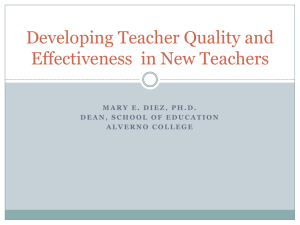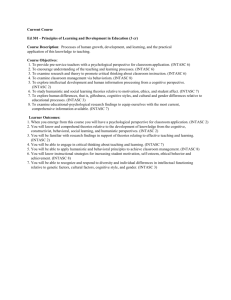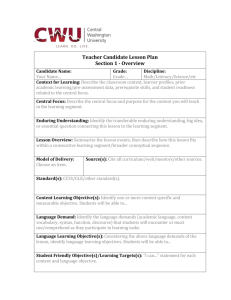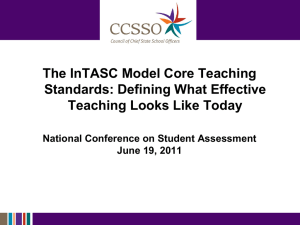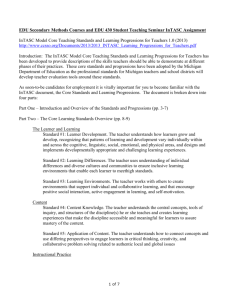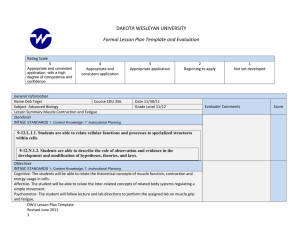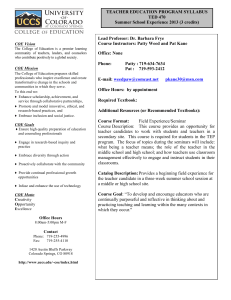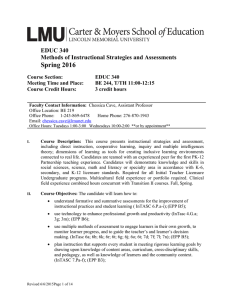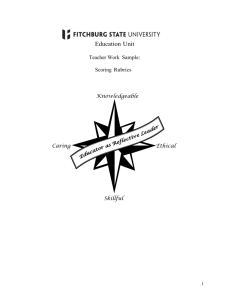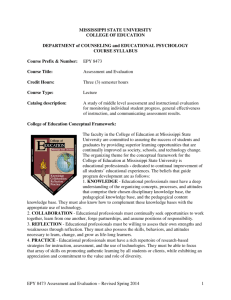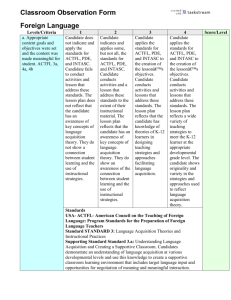Student Teaching Portfolio Assessment Rubric
advertisement
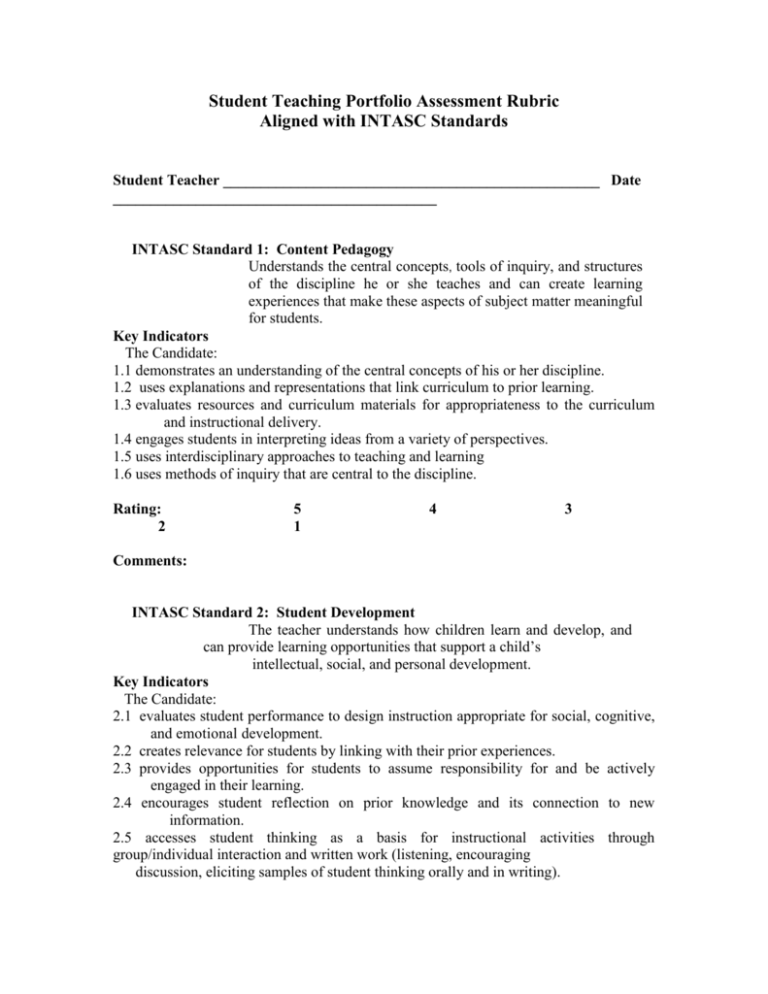
Student Teaching Portfolio Assessment Rubric Aligned with INTASC Standards Student Teacher __________________________________________________ Date ___________________________________________ INTASC Standard 1: Content Pedagogy Understands the central concepts, tools of inquiry, and structures of the discipline he or she teaches and can create learning experiences that make these aspects of subject matter meaningful for students. Key Indicators The Candidate: 1.1 demonstrates an understanding of the central concepts of his or her discipline. 1.2 uses explanations and representations that link curriculum to prior learning. 1.3 evaluates resources and curriculum materials for appropriateness to the curriculum and instructional delivery. 1.4 engages students in interpreting ideas from a variety of perspectives. 1.5 uses interdisciplinary approaches to teaching and learning 1.6 uses methods of inquiry that are central to the discipline. Rating: 2 5 1 4 3 Comments: INTASC Standard 2: Student Development The teacher understands how children learn and develop, and can provide learning opportunities that support a child’s intellectual, social, and personal development. Key Indicators The Candidate: 2.1 evaluates student performance to design instruction appropriate for social, cognitive, and emotional development. 2.2 creates relevance for students by linking with their prior experiences. 2.3 provides opportunities for students to assume responsibility for and be actively engaged in their learning. 2.4 encourages student reflection on prior knowledge and its connection to new information. 2.5 accesses student thinking as a basis for instructional activities through group/individual interaction and written work (listening, encouraging discussion, eliciting samples of student thinking orally and in writing). Rating: 2 5 1 4 3 Comments: INTASC Standard 3. Diverse Learners The teacher understands how students differ in their approaches to learning and creates instructional opportunities that are adapted to diverse learners. Key Indicators The Candidate: 3.1 designs instruction appropriate to students’ stages of development, learning styles, strengths and needs. 3.2 selects approaches that provide opportunities for different performance modes. 3.3 accesses appropriate services or resources to meet exceptional learning needs when needed. 3.4 adjusts instruction to accommodate the learning differences or needs of students (time and circumstance of work, tasks assigned, communication and response modes). 3.5 uses knowledge of different cultural contexts within the community (socio-economic, ethnic, cultural) and connects with the learner through types of interaction and assignments. 3.6 creates a learning community that respects individual differences. Rating: 2 5 1 4 3 Comments: INTASC Standard 4. Multiple Instructional Strategies The teacher understands and uses a variety of instructional strategies to encourage student development of critical thinking, problem solving, and performance skills. Key Indicators The Candidate: 4.1 selects and uses multiple teaching and learning strategies (a variety of presentations/explanations) to encourage students in critical thinking and problem solving. 4.2 encourages students to assume responsibility for identifying and using learning resources. 4.3 assumes different roles in the instructional process (instructor, facilitator, coach, audience) to accommodate content, purpose, and learner needs. Rating: 2 Comments: 5 1 4 3 INTASC Standard 5. Motivation and Management The teacher uses an understanding of individual and group motivation and behavior to create a learning environment that encourages positive social interaction, active engagement in learning, and self-motivation. Key Indicators The Candidate: 5.1 encourages clear procedures and expectations that ensure students assume responsibility for themselves and others, work collaboratively and independently, and engage in purposeful learning activities. 5.2 engages students by relating lessons to students’ personal interests, allowing students to have choices in their learning, and leading students to ask questions and solve problems that are meaningful to them. 5.3 organizes, allocates, and manages time, space and activities in a way that is conducive to learning. 5.4 organizes, prepares students for, and monitors independent and group work that allows for full and varied participation of all individuals. 5.5 analyzes classroom environment and interactions and makes adjustments to enhance social relationships, student motivation/engagement and productive work. Rating: 2 5 1 4 3 Comments: INTASC Standard 6. Communication and Technology The teacher uses knowledge of effective verbal, nonverbal, and media communication techniques to foster active inquiry, collaboration, and supportive interaction in the classroom. Key Indicators The Candidate: 6.1 models effective communication strategies in conveying ideas and information and when asking questions (e.g., monitoring the effects of messages; restating ideas and drawing connections; using visual, aural, and kinesthetic cues; being sensitive to nonverbal cues both given and received). 6.2 provides support for learner expression in speaking, writing, and other media. 6.3 demonstrates that communication is sensitive to gender and cultural differences (e.g., appropriate use of eye contact, interpretation of body language and verbal statements, acknowledgement of the responsiveness to different modes of communication and participation. 6.4 uses a variety of media communication tools to enrich learning opportunities. Rating: 2 5 1 4 3 Comments: INTASC Standard 7. Planning The teacher plans instruction based upon knowledge of subject matter, students, the community, and curriculum goals. Key Indicators The Candidate: 7.1 plans lessons and activities to address variation in learning styles and performance modes, multiple development levels of diverse learners, and problem solving and exploration. 7.2 develops plans that are appropriate for curriculum goals and are based on effective instruction. 7.3 adjusts plans to respond to unanticipated sources of input and/or student needs. 7.4 develops short and long-range plans. Rating: 2 5 1 4 3 Comments: INTASC Standard 8. Assessment The teacher understands and uses formal and informal assessment strategies to evaluate and ensure the continuous intellectual, social, and physical development of the learner. Key Indicators The Candidate: 8.1 selects, constructs, and uses assessment strategies appropriate to the learning outcomes. 8.2 uses a variety of informal and formal strategies to inform choices about student progress and to adjust instruction (e.g., standardized test data, peer and student self-assessment, informal assessments such as observation, surveys, interviews, student work, performance tasks, portfolio, and teacher made tests). 8.3 uses assessment strategies to involve learners in self-assessment activities to help them become aware of their strengths and needs, and to encourage them to set personal goals for learning. 8.4 evaluates the effects of class activities on individuals and on groups through observation of classroom interaction, questioning and analysis of student work. 8.5 maintains useful records of student work and performance and can communicate student progress knowledgeably and responsibly. 8.6 solicits information about students’ experiences, learning behavior, needs, and progress from parents, other colleagues, and students. Rating: 2 5 1 4 3 Comments: INTASC Standard 9. Reflective Practice Professional Development The teacher is a reflective practitioner who continually evaluates the effects of his or her choices and actions on others and who actively seeks out opportunities to grow professionally. Key Indicators The Candidate: 9.1 uses classroom observation, information about students and research as sources for evaluating the outcomes of teaching and learning and as a basis for experimenting with, reflecting on, and revising practice. 9.2 uses professional literature, colleagues, and other resources to support selfdevelopment as a learner and as a teacher. 9.3 consults with professional colleagues within the school and other professional arenas as support for reflection, problem-solving and new ideas, actively sharing experiences, and seeking and giving feedback. Rating: 2 5 1 4 3 Comments: INTASC Standard 10. School and Community Involvement The teacher fosters relationships with school colleagues, parents, and agencies in the larger community to support students’ learning and well-being. Key Indicators The Candidate: 10.1 participates in collegial activities designed to make the entire school a productive learning environment. 10.2 links with counselors, teachers of other classes and activities within the school, professionals in community agencies, and others in the community to support students’ learning and well- being. 10.3 seeks to establish cooperative partnerships with parents/guardians to support student learning. 10.4 advocates for students. Rating: 2 5 1 4 3 Comments: SCORING KEY: 5 = Exceeds Standard 4 Meets all but one Indicator for Standard 3 Meets Standard but missing and indicator or reflection (comments) are weak 2= Developing Competency, but only½ of all indicators for standard are met 1) Minimally meets indictors; reflections (comments) are weak

